
How Ecommerce Brands Can Create a Conversion-Powered Customer Journey Map
A 5 step process to help you build a customer journey map for your ecommerce brand that identifies opportunities to improve conversions.
Do you know your customers well? Are you able to track their journey with your brand from start to finish? If the answer to either of these questions is no, you likely have a major blindspot into your customers’ motivations and needs. And therefore, you probably aren’t providing a great customer experience.
Understanding the route your customers take to purchase means stepping into their shoes and getting to grips with their pain points, objections, and goals. Doing this will ensure you give them all the information they need, exactly when they need it.
Building a strong ecommerce customer experience
The customer’s experience is everything for ecommerce brands. The sheer amount of competition means that if a customer isn’t happy with the service or can’t find what they’re looking for, there are plenty of other places for them to go. On the flip side, if you provide a stellar experience that’s smooth and enjoyable, there’s a good chance customers will come back and become loyal over time.
In fact, a study by XM found:
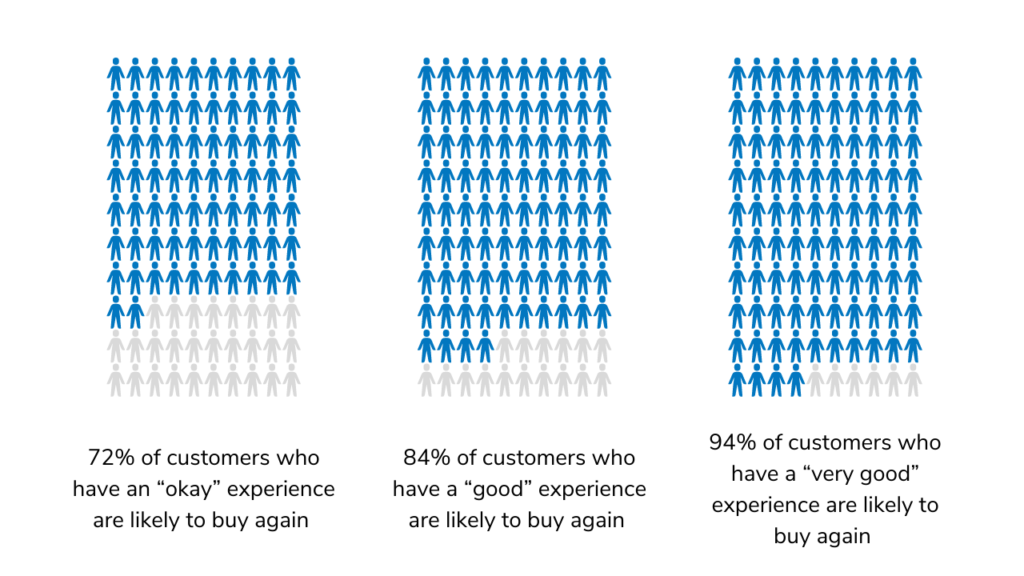
- 72% of customers who have an “okay” experience are likely to buy again
- 84% of customers who have a “good” experience are likely to buy again
- 94% of customers who have a “very good” experience are likely to buy again
Ramping up the customer experience from an “okay” experience to “very good” can improve the chances of customers returning by 22%.
But where do you even start?
Identifying your customers’ key needs and pain points can feel daunting, especially if you don’t have a clear idea about who you’re serving. However, once you start to dig into the different stages of the customer journey, you can determine what customers need at each and every touchpoint.
Enter the customer journey map.
This is a visual representation of how customers move through your website, from the initial discovery of your brand right up until the point of sale and beyond. The benefits of customer journey mapping are self-evident, but it mostly helps identify user experience pain points and craft thoughtful experiences aimed at minimizing customer objections.
Want a 12 minute walk-through of how to create a customer journey map?
What is a customer journey map?
A customer journey map does exactly as it says on the tin: it illustrates the journey a customer might take with your brand. Essentially, it covers each step they take from start to finish, from how they find you to where they end up (whether that’s making a purchase or jumping ship to a competitor).
Having a meaningful customer journey map is the first step in creating a strong conversion rate. The better you understand the journey your customers take, the easier it is to optimize each stage for more engagement and sales.
For example, a simple customer journey map for an ecommerce brand might look something like this:
- Discovers the website via an Instagram ad
- Checks out the product page and reads several reviews
- Buys the product
- Shares their experience with others
- Upgrades the product or replaces the product
This is just a sample journey, and it’s often the case that no two customer journeys are the same (and they’re very rarely linear like this one).
Some customers might skip one stage of the journey completely if they’ve received a solid recommendation from a friend, while others might hang around the research stage for a bit longer, especially if they’re buying a high ticket item.
Don’t confuse the term customer journey with buyer lifecycle, either.
It’s a common mistake ecommerce brands make, but defining the key differences between each one will help you take on a customer-centric mindset.
The customer journey is all about understanding the route to purchase from the customer’s perspective, while the buyer lifecycle is understanding it from the business side. Put simply, the customer journey covers all of the customer-facing experiences that visitors to your ecommerce store will have.
How to make a customer journey map in 5 steps
Creating a customer journey map means stepping into your customers’ shoes and documenting all of the potential touchpoints they might interact with.
To start, it’s a good idea to gather a small group of three or four customer experts in a room. These should be people who understand your customers, what they want, and how they behave. For example, you might get a customer service rep, a marketer, a merchandiser, and a copywriter together, each of whom has a different kind of working knowledge about your customer base.
Their diversity of embedded expertise will be useful in building a complete picture of what users experience, which you can use together with in-depth customer research, metrics, and hard data.
As you’re creating your customer journey map, there are four things that should be at the front of your mind:
- Actions: What actions customers are taking at each stage and how they are moving onto the next stage
- Motivations and emotions: Why the customer is motivated to move onto the next stage and what emotions they’re feeling as they do so
- Questions, doubts, or objections: What questions, doubts, and objections are stopping customers from moving to the next stage
- Barriers: What barriers customers come up against that makes them hesitant to move forward
Now it’s time to get started.
Step 1: Define your character and the situation
At the root of every customer journey map is the customer.
Every brand has a unique relationship with its customers, so it’s important that you understand who you’re dealing with. This involves going deeper than surface-level demographic information and digging into psychographic tendencies and customer behavior.
You don’t need a fully-flushed customer persona to make this work. Instead, it’s about using the information you already know about your customers to outline what a user might go through before, during, and after a purchase.
When defining the character whose journey you will map in this exercise think about someone who paints a clear picture for you. Here are two examples:
- Katy: A working mom setting up her home gym
- Dean: A recent college graduate purchasing their first new car
Once you’ve landed on your character, you should be able to describe them in one sentence, but give them life with a few persona-like details. “Katy is a working mom. Her kids leave for school at 8 am and she has only a half-hour before she starts work. She’s motivated to make the most of that time by creating an efficient home gym.”
Crafting a character and a situation that your team can clearly envision will make it easy for the experts in the room to map a life-like customer journey in the steps to come.
Enjoying this article?
Subscribe to our newsletter, Good Question, to get insights like this sent straight to your inbox every week.
Step 2: Define the different stages of the customer journey
The common stages involved in the customer journey are awareness, consideration, and decision. Each stage demands different information for customers and requires a unique set of touchpoints in order to drive conversions.
- Awareness: customers are just becoming aware that they have a problem that needs solving and are educating themselves on potential solutions
- Consideration: customers know what solution they need and begin to research their options
- Decision: customers settle on a product or service and make a purchase
Say, for example, a customer is looking for a new eco-friendly water bottle:
- Awareness: they might have been using plastic bottles for a while and have read up about why they should change them for reusable bottles.
- Consideration: once they’ve decided they need to buy an eco-friendly water bottle, they might start researching which ones are available (the answer: a lot) and spend some time trawling through product pages and comparing brands.
- Decision: at some point, there will be a clear winner, whether it’s because the bottle looks how they want it to look, uses the right materials, has great reviews, or is in their budget, and they will go ahead and buy it.
There is also a post-purchase stage of the customer journey where customers turn into loyal, repeat buyers.
Take the eco-friendly water bottle example again. While shoppers may not repeat the purchase for themselves, they might be interested in a gift for a friend or a complimentary reusable utensil step.
Step 3: Define the steps in each stage
The aim is to move customers seamlessly from one stage to the next. At this point, you’ll need to know what customers need from you at each of these stages. It helps to have your customer research to hand here to identify the major pain points and objections buyers might have.
Let’s use the eco-friendly water bottle example again and plot out the potential user goals for the customer journey:
- Awareness: notice my recycling is always full and hear the media say that microplastics are bad, and that recycling doesn’t work
- Consideration: start thinking about how I can reduce plastic waste and look up search terms associated with this, like “best reusable bottle”
- Decision: choose the company that aligns with my values and that I feel the most drawn to
When you know the steps for each stage, you can then assign customer touchpoints that tie into these steps and help push customers through the journey.
Step 4: Identify (and implement) touchpoints at each stage
The steps provide the backbone of your customer journey, and now it’s time to incorporate touchpoints that align with these steps. These touchpoints are where your customers might be interacting with content related to their purchase, such as ads, search engines, or via word-of-mouth.
This might look something like this:
- Awareness: blog posts, social media copy, and ads educating customers on the pros of eco-friendly bottles and a CTA to drive them to your site
- Consideration: testimonials, reviews, detailed product descriptions, and instant customer support to pitch your water bottle as the best and tackle any objections
- Decision: videos of your water bottle in action, more reviews, and an easy checkout system
Touchpoints can come in many shapes and sizes and refer to any moment a customer has contact with your brand (these are often dubbed “moments of truth”). Just remember that they should align with the goals you want to achieve at each stage. Keeping in mind all the places your customers might hear about or engage with your brand or product will help you create a more holistic ecosystem and uncover blind spots in your marketing strategies.
They might include:
- Online ads and social media campaigns
- Offline advertising methods
- Blog posts, ebooks, and on-site content
- Case studies
- Infographics and other visual media
- Social media posts
- Email marketing messages
- Customer support
- Order confirmation
- Packaging and delivery
Don’t forget about the post-purchase touchpoints too, as the stronger these are the more likely a customer is to come back and buy from you again.
Step 5: Tap into user thoughts and tackle any objections
Not every customer is going to make it all the way through the journey to purchase.
Some might choose a competitor, or others might change their mind at the last minute. Whatever the timing, it helps to know why customers are likely to drop out of the journey so you can bolster the touchpoints and address pain points in those stages.
Ask yourself what your customer might be feeling throughout the journey. Identify objections to better understand why they might be hesitant to convert. Then attach sentiment to each stage of the journey so you can pinpoint parts of the customer experience where emotions are extremely high or low.
At the high points, consider taking advantage of that momentum to add a personal touch, a special reward, an exclusive offer, or a request for a review/referral.
At the low points, consider ways that you might be able to improve customer sentiment through site design, proactive messaging, reassurances/social proof, etc.
Customer journey map examples from winning ecommerce brands
Customer journey maps will look different for every company. The examples we’ve got here are pretty thorough and come from well-resourced companies. Yours doesn’t have to be this detailed straight out of the gate! The first version for many companies (particularly small ones) will often fit on the back of a sheet of paper or a whiteboard but will get more detailed over time as you learn more about your customers through ongoing research.
Amazon is the biggest ecommerce brand in the world and, as such, it has an incredibly complicated customer journey map.
Customers might find the brand in a variety of ways, from ads, links in blog posts, referrals, or simply by visiting direct, and the consideration stage involves a lot more research since there are so many options.
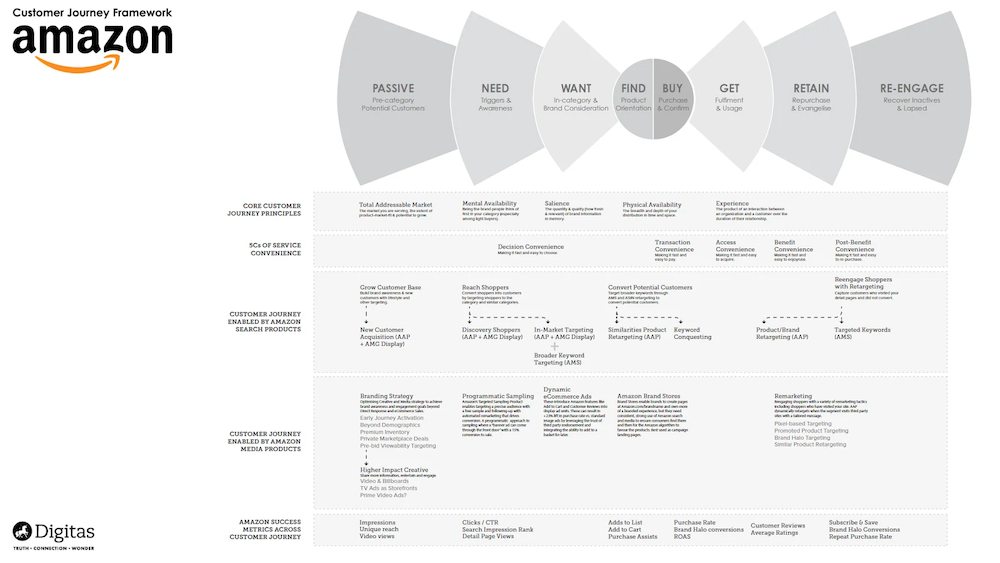
Amazon bolsters the experience and keeps customers moving forward by adding touchpoints such as:
- Personalized product recommendations
- Reviews
- Shopping guides
- One-click to buy
- Comparison charts
- Detailed product descriptions
- Paid ads
Lancome’s customer journey map highlights customers’ needs at each stage of the journey. The brand defines the different stages as “on my way”, “getting Lancome”, and “share experience”, with key worries, objections, and questions mapped out for each of these stages.
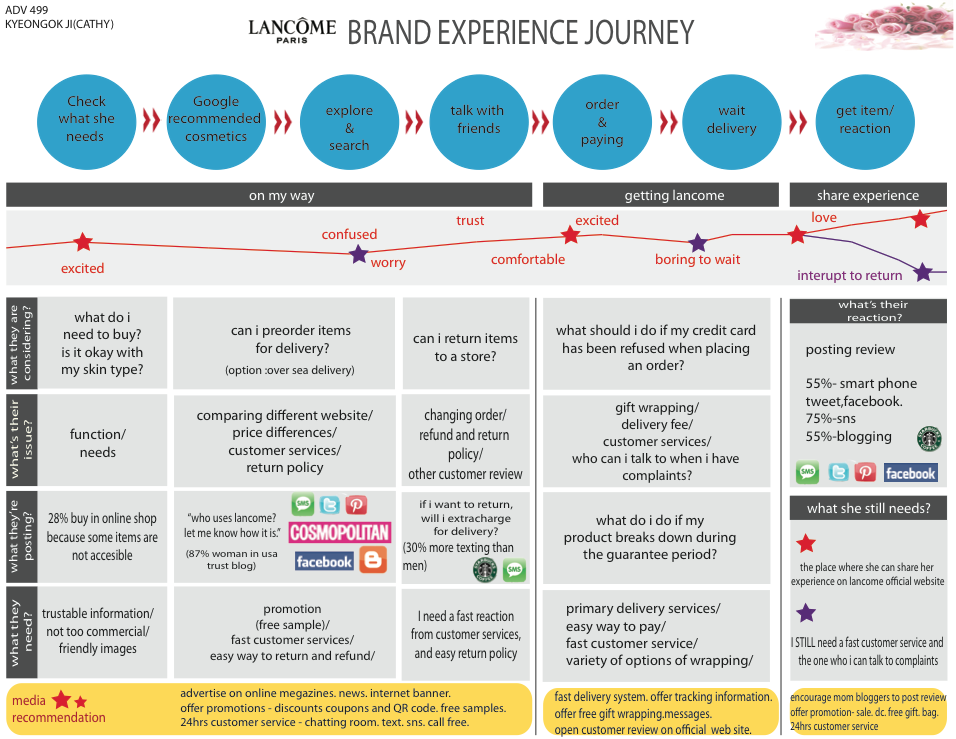
For each stage, there are media recommendations that act as touchpoints, including discounts and coupons, free samples, customer reviews, and influencer marketing campaigns.
Electronics provider Samsung has multiple touchpoints on its website, each of which loosely fall into the three stages of the customer journey:
- Awareness: blog posts and content as part of the #DoWhatYouCant campaign to inspire potential buyers
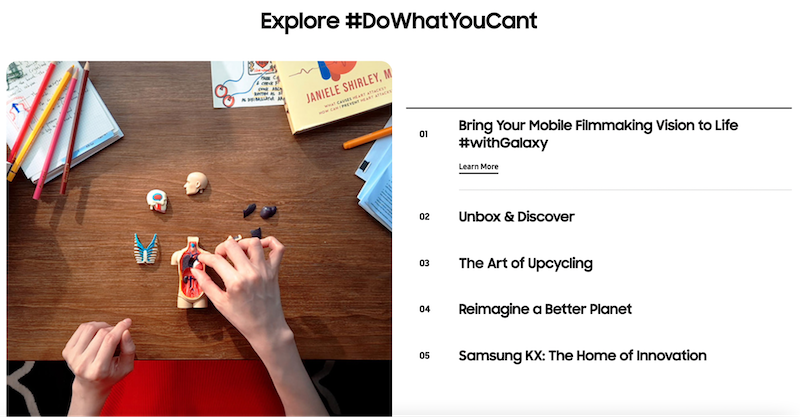
- Consideration: helpful product pages that include comparison lists, high-quality photos, videos, reviews, and a pop-up live customer support channel
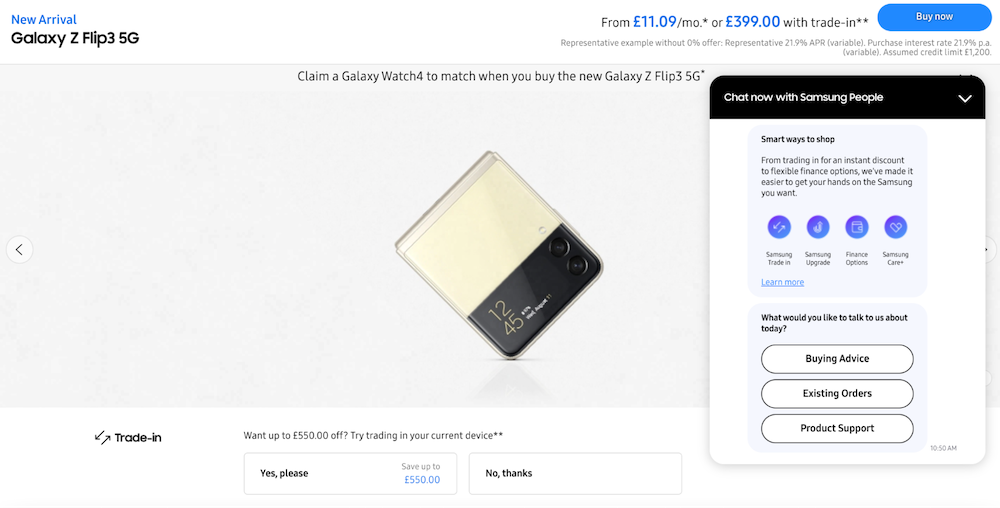
They also have a pop-up offer for customers that look like they’re about to leave the site.

- Decision: an easy checkout process with additional upsells and cross-sells to increase customer retention and cement customer loyalty
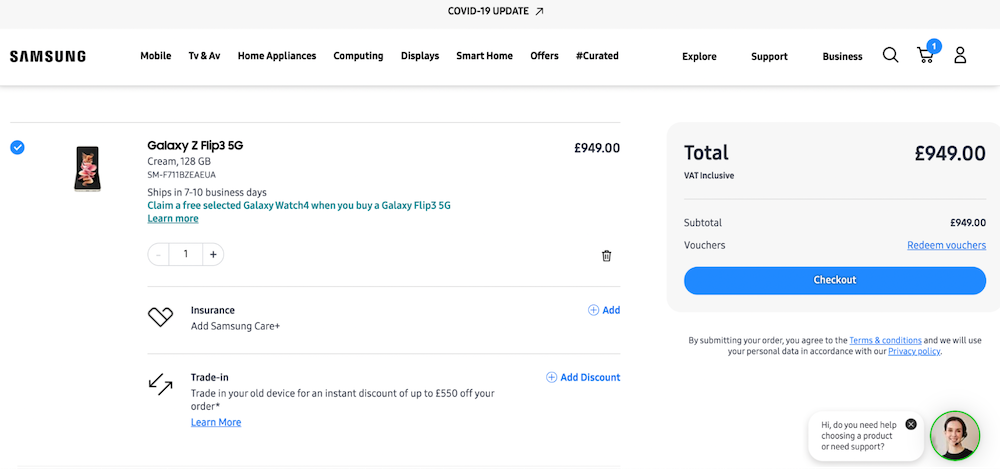
A strong customer journey map is the beginning of a strong conversion rate
Your customer journey map is the backbone of the customer experience.
It drives buyers from one stage to the next by understanding their unique pain points and offering content that tackles any objections. As a result, customers will glide seamlessly through the process, hitting each relevant touchpoint and getting the exact information they need, exactly when they need it.
It’s a no-brainer that a strong customer journey map leads to a stronger conversion rate. When you have a strong map, less customers drop out of the journey, and more make it all the way to the point of sale.
Subscribe to our weekly insights for more customer experience content.
Enjoying this article?
Subscribe to our newsletter, Good Question, to get insights like this sent straight to your inbox every week.

About the Author
Natalie Thomas
Natalie Thomas is the Director of Digital Experience & UX Strategy at The Good. She works alongside ecommerce and product marketing leaders every day to produce sustainable, long term growth strategies.